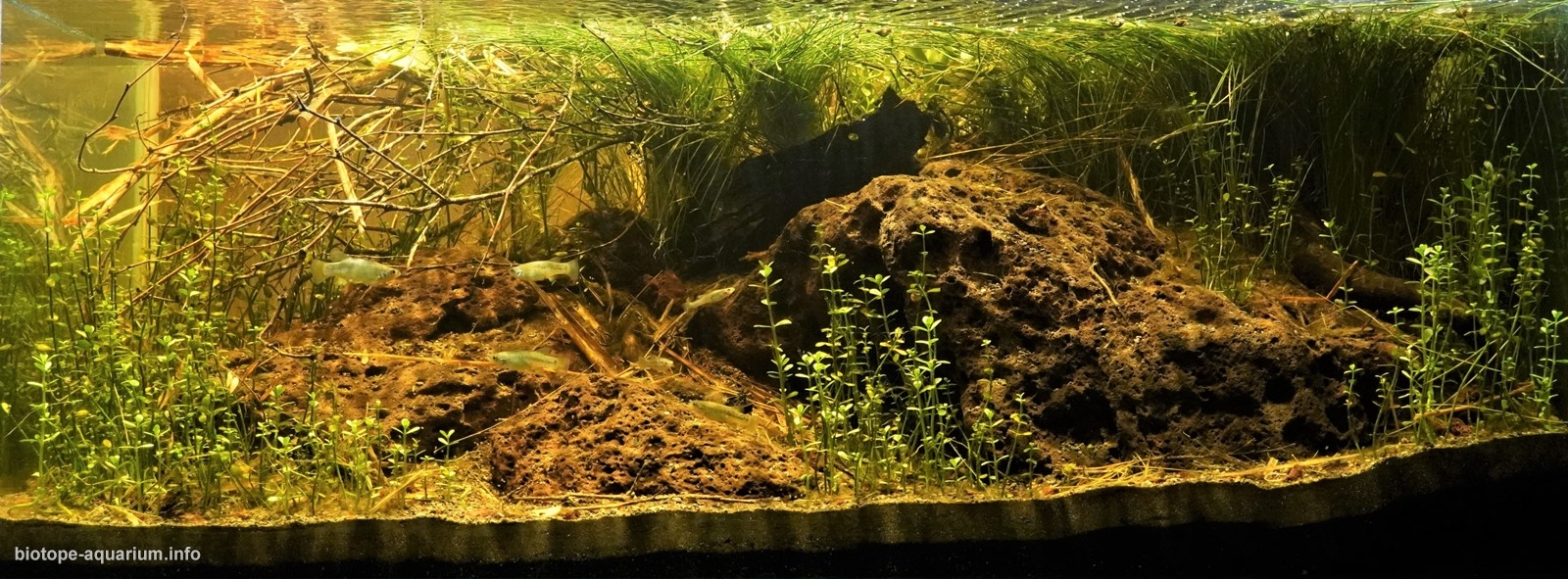Cuitzeo lake rock zone riverside, Ejido las Trojes, Mexico
_th place in Biotope Aquarium Design Contest 2020

Volume: 283 L
Dimensions: 120 X 60 X 45 cm
List of fishes: Xenotoca variata, Poeciliopsis infans, Physella acuta, Planorbidae sp. and Daphnia sp.
List of plants: Bacopa monnieri, Eichhornia crassipes, Eleocharis montevidensis, and Lemna sp.
Description of decorations: Through red volcanic rock with rounded edges, natural substrate mixture of sand and mud, leaves, seeds, some fallen branches and driftwood.(all this extracted from the habitat of areas where the environmental impact was minimal) The recreation of rock zone the lake shore was carried.
Description of equipment: Basket filter BOYU EF45, with flow capacity of 1100 liters / hour, it uses 3 different thicknesses of sponge as Azoo mechanical filter and 2 liters of Matrix Seachem brand for the filter biological. The lighting consists of 3 IUSA brand reflectors of 4500 lumens each at a temperature of 6500° K. No equipment is used to regulate the temperature.
Water parameters: The parameters were measured by PRO JBL Scan, Nitrate (NO3): 5 mg/l, Nitrite (N02): 0.25 mg/l, Total hardness (GH): >4 d°, Carbonate hardness (KH): 5 d°, PH: 7.6 and Temperature: 22°C.
INFORMATION ABOUT BIOTOPE
Description of the area surrounding the biotope: Lake Cuitzeo is an endorheic lake located in a valley of the neo-volcanic axis of Mexico occupies the second place in surface between the lakes of the country covering an area of 4026km2, is fed mainly by the large river Morelia and surrounding streams, there are theories that indicate in this place about 12900 years ago an extraterrestrial impact was given due to the identification of materials in a sediment. In the geographic coordinates 19°56’44.0″N 101°03’12.8″W where it locates the biotope that is being represented is surrounded mainly by plains, which in the past were part of it since they were dried for agricultural use, Nowadays, the adjacent lands are used to raise livestock freely, feeding them on the fauna that grows on the riverbank and the surrounding area. There are also reliefs of clay and volcanic rock, covered by flora such as Prosopis glandulosa, Eysenhardtia polystachya and Acacia pennatula in its mostly.
Description of the underwater landscape of the biotope: To the naked eye it is a lake of turbid waters, however, it keeps in its margins very calm waters of little turbidity, where one can see another very different landscape, among the rocks grow diverse aquatic plants that are born from the shore, that is composed of a mixture of reddish volcanic rock and mix of sand and mud, leaves, seeds, some fallen branches, some plants float calmly while others emerge from the shallow bed that does not exceed 50 cm.
Description of the parameters of the habitat: The parameters were measured by PRO JBL Scan, Nitrate (NO3): 16 mg/l, Nitrite (N02): 0.25 mg/l, Total hardness (GH): <3 d°, Carbonate hardness (KH): 4 d° , PH: 7.4 to 8.8 and the temperature varies according to the season of the year from 14°C to 24°C but maintains an average temperature of 20°C.
List of fishes and invertebrates occurring in the nature biotope: Xenotoca variata, Cyprinus carpio, Moxostom austrinum, Oreochromis niloticus, Micropterus salmoides, Alloophorus robustus, Poeciliopsis infans, Planorbidae sp. and Physa acuta.
List of plants found in the nature biotope: Bacopa monnieri, Eichhornia crassipes, Eleocharis montevidensis and Lemna sp.
Threats to the ecology: Domestic, industrial, agricultural and livestock wastewater that is introduced into the lake causes the lake’s water quality to become contaminated and slowly degenerate, slowly reducing the health of the flora and fauna that inhabit it, in addition to the low rainfall that occurs present today, generate a state of alert to the possible disappearance of the lake.
Sources of information:
- Photos of the natural biotope. web: https://drive.google.com/drive/folders/1arARWu6Ej9EIymqXFAV9C70MkQC_wXUk?usp=sharing
- Rojas Moreno, José; Novelo Retana, Alejandro. (1995). Flora y vegetación acuáticas del Lago de Cuitzeo, Michoacán, México. 31/07/2018, de Instituto de Ecología, A.C. web: https://abm.ojs.inecol.mx/index.php/abm/article/view/733/899
- Silke Cram, Leopoldo Galicia e Isabel Israde. (2010). Atlas de la Cuenca del Lago Cuitzeo: análisis de su geografía y entorno socioambiental. 31/07/2018, de Universidad Nacional Autónoma de México. web: https://www.researchgate.net/profile/Silke_Cram/publication/268523934_Atlas_de_la_Cuenca_del_Lago_Cuitzeo_analisis_de_su_geografia_y_entorno_socioambiental/links/57b78c6008ae14f440b a3690/Atlas-de-la-Cuenca-del-Lago-Cuitzeo-analisis-de-su-geografia-y-entorno-socioambiental.pdf
